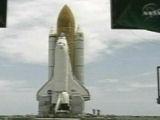
...Across the Universe
They have started to move Space Shuttle Discovery to Cape Canaveral in preparation for the next launch scheduled in July.

Here we go again. It's always scary.
Air Force Col. Steven Lindsey will command the next mission, designated STS-121. The shuttle is to dock with the international space station, delivering supplies and dropping off German astronaut Thomas Reiter.
Shuttle astronauts Piers Sellers and Mike Fossum are scheduled to conduct at least two spacewalks while the Discovery is docked with the space station.
The first will test the stability of the shuttle's new second robotic arm, called the Orbiter Boom Sensor System, as a work platform. The second is to repair part of the station's mobile transporter, a train track on the exterior that permits its robotic arm to move around.
If time permits, Sellers and Fossum may conduct a third spacewalk to test techniques to repair damage to the shuttle's thermal protection system.
NASA intends to retire the shuttle fleet in 2010 after completing assembly of the international space station.
The next-generation manned spacecraft, called the Crew Exploration Vehicle, is in the design stage. NASA says it hopes to begin test flights in 2012.
More Apewatch
Some apes have demonstrated they have the capacity to think ahead.
Nicholas Mulcahy and Josep Call of the Max Planck Institute for Evolutionary Anthropology in Leipzig tested whether our closest great ape relative--the bonobo--and our most distant--the orangutan--share our ability to plan for the future. The researchers first trained five bonobos and five orangutans to use a tool to get a fruit treat from a mechanical apparatus. They then blocked access to the treat but allowed the apes to handle suitable and unsuitable tools for the task before ushering them into a waiting room for an hour. After that hour, they were brought back into the first room and, if they had brought the right tool, they could use it to get the treat.How come some people I know have lost this ability? :)
The apes both took a suitable tool out of the test room and brought it back in with them after the waiting period significantly more often than predicted by chance. A female orangutan named Dokana proved particularly adept, completing the task successfully in 15 out of 16 attempts. Even when the delay time was extended through the night--14 hours--Dokana succeeded in garnering the tool and the fruit more than half of the time. A bonobo named Kuno did even better with the long delay than the short one, completing the task in eight out of 12 attempts.
To determine whether the apes were simply associating the tool with the food reward, or whether they were actively planning ahead, the researchers devised two more tests. In the first, two of the bonobos and two of the orangutans faced a similar challenge but with only juice as a reward--to discount for the possibility that the apes had taken the right tool previously simply because they were currently hungry. Again, the apes proved capable.
Finally, some naïve apes were presented with tools but not the mechanical apparatus. If they brought back the right tool they were still rewarded with a treat. But most did not, seemingly disproving a simple associative link between the tool and the treat. "Apes selected, transported and saved a suitable tool not because they currently needed it but because they would need it in the future," the authors write in the paper presenting the research in today's Science.
That bonobos and orangutans can plan ahead suggests that the ability evolved in the great apes prior to 14 million years ago rather than in our hominid forebearers within the past 2.5 million years, the scientists note. And other creatures may have undergone convergent cognitive evolution. Indeed, another study published online yesterday by Science found that scrub jays hid and re-hid food depending on whether they were watched by other birds.
From The Mailbag
Pleaides sent in this link. We may have gone too far.
Record amounts of the Arctic ocean failed to freeze during the recent winter, new figures show, spelling disaster for wildlife and strengthening concerns that the region is locked into a destructive cycle of irreversible climate change.And so on.
Satellite measurements show the area covered by Arctic winter sea ice reached an all-time low in March, down some 300,000 square kilometres on last year -an area bigger than the UK.
Scientists say the decline highlights an alarming new trend, with recovery of the ice in winter no longer sufficient to compensate for increased melting in the summer. If the cycle continues, the Arctic ocean could lose all of its ice much earlier than expected, possibly by 2030.
Walt Meier, a researcher at the US National Snow and Ice Data Centre in Colorado, which collected the figures, said: "It's a pretty stark drop. In the winter the ice tends to be pretty stable, so the last three years, with this steady decline, really stick out."
Experts are worried because a long-term slow decline of ice around the north pole seems to have sharply accelerated since 2003, raising fears that the region may have passed one of the "tipping points" in global warming. In this scenario, warmer weather melts ice and drives temperatures higher because the dark water beneath absorbs more of the sun's radiation. This could make global warming quickly run out of control.
Dr. Meier said there was "a good chance" the Arctic tipping point has been reached. "People have tried to think of ways we could get back to where we were. We keep going further and further into the hole, and it's getting harder and harder to get out of it."
bad news for the polar bears, it says.

No comments:
Post a Comment